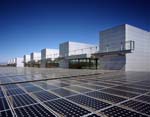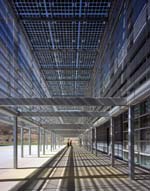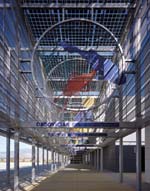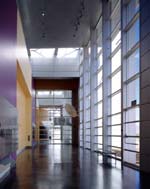
|
|
|
|
 |
|
Home Site Search Contact Us Subscribe
|
|
|
|
Water = Life: Diamond Valley Water + Life Museums Campus by Lehrer + Gangi Design + Build
Hemet, CA: Two museums in the desert offer engaging environmental lessons, both inside and out. By ArchNewsNow April 11, 2007 The Diamond Valley Water + Life Museums Campus in Hemet, California, celebrates the link between Southern California’s water infrastructure and the evolution of life. Los Angeles-based Lehrer + Gangi Design + Build created a crisp, modern design concept that envelops the 23-acre campus and includes two sister museums – The Center for Water Education and Western Center for Archaeology and Paleontology – along with laboratories, classrooms, administrative offices, support facilities, gift shop, café, and interpretive/educational landscape. Phase 2 includes and outdoor amphitheatre, front and courtyard water features, two auditoriums, and a canal.
The 62,215-square-foot, $36.8 million campus is a striking mélange of metal and glass at the eastern entrance to the 4,500-acre Diamond Valley Lake. The architectural idea for the museums is derived from the history of the Metropolitan Water District of Southern California’s monumental architecture, such as Gordon B. Kaufman’s Parker Dam pump buildings at Lake Havasu.
Five slender steel towers blaze across each structure’s façade, providing an eloquent contrast against the azure desert skyline. The monoliths are clad in crenellated steel, evoking the minimalist sculpture of Donald Judd. These primal forms have a timeless quality sitting in the landscape, and recall the turbines in a row or the grills that the water goes through in its processing.
Translucent banners hang across 10,000 square feet of east-facing glass. Printed with pixilated images, the banners not only identify the museums (tusks for Archeology; lake for Water), but also mitigate the strong desert sun.
A broad plaza between the buildings frames the desert landscape. Latticed loggias on either side of the buildings create a dramatic processional through filtered light. The layering of perforated steel slats and custom-made solar tiles adds depth and movement to the loggias.
The 23,000-square-foot water museum incorporates such educational components as a simulated dam, two aquarium spaces, and interactive exhibits to tell the story of water. Through education and delight, the museum’s mission is to develop the public as stewards of water and water conservation.
The 33,000-square-foot archeological center across the plaza houses an interactive theater in the round, research lab, archaeology and paleontology labs, and 9,000 square feet of specimen storage. While the earthen dams were cut 100 feet into bedrock to create Diamond Valley Lake, remains from the Pleistocene era were found and are now on display at the archeology museum.
Sustainability
The building program is a “living” example of sustainability and conservation, which further connects the notions of water and life. Green design elements cast the complex’s energy standards above the required minimum of California Title 24 Energy Conformance. The museum campus was built to achieve LEED (Leadership in Energy and Environmental Design) Platinum certification from the U.S. Green Building Council; efficient design features range from dual-flush toilets to broad expanses of solar panels.
The buildings’ rooftop photovoltaic installation has a 540-kilowatt solar-power system of 3,000 solar panels, and generates energy for 47% of the museum campus (68% of the museum buildings themselves). It requires minimal maintenance, and lowers the toxic outpour of carbon dioxide into the atmosphere. The solar-power system, whose roof-mounted panels provide shading that will extend the roof-covering life by about 25%, boasts a projected net savings of about $13 million during its lifespan. A specially designed solar power display in the museum provides an interactive display so visitors can learn and request information on the solar power co-generation system.
The interior lighting design includes a network of electronic sensing devices and timers that optimize daylight harvesting and program zone lighting controls in all buildings. Office lighting is monitored by occupancy sensors or photoelectric controls, while outdoor banner projectors use minimal electrical power via light-emitting-diode (LED) lamps.
Heating and cooling are conducted through a sophisticated mechanical system of radiant flooring and forced air units. Translucent banners hanging in front of high-performance curtain walls at the east elevation mitigate heat radiation.
Landscape
Designed as an environmental learning experience, the architecture and the landscape for arid campus were conceived from the beginning as one. The arrival procession introduces the principal qualities of water through the meandering braided stream toward the parking lot and the (Phase 2) water features at the front of the building, illustrating the importance irrigation and agriculture have played in the history of water infrastructure and use in California. Additional components of the outdoor learning exhibits include: archaeological digs, Paleolithic habitats, industrial and cultural water uses, water conservation, water uses in the future, and local Native American settlements.
The approach to planting within the campus has been sensitively and thoroughly researched to maintain the delicate ecological balance of the region and the environmental conditions of the site. Biologists collaborated with the design team to establish a plant list that responds to and is aligned with the Metropolitan Water District’s mission statement on sustainability, its drought-tolerant approach to the landscape, and its commitment to educating the public about water conservation. Disease- and infestation-resistant plants that thrive in hot, dry climates were selected. Shade trees and other landscape elements create a comfortable environment to explore the interpretive exhibits.
Sustainable elements of the landscape program include braided streams containing pervious surfaces to provide storm water management by conveying rainwater to the water table. Irrigation systems are state-of-the-art drip systems that use reclaimed water. Surfaces are made of naturally colored red and green decomposed granite.
Thousands of large, sculptural stones were part of the detritus resulting from drilling 100 feet into bedrock during the building process. The rocks were seen as waste until the design team incorporated them as major landscape features.
Project Credits Clients: The Center for Water Education; Western Center for Archeology and Paleontology Architect: Lehrer + Gangi Design + Build Project Team: Michael B. Lehrer, FAIA (Principal), Mark Gangi, AIA (Co-Lead Design Principal), Frank P. Gangi, MBA (Construction Manager), Anne Marie Kaufman Perlov, LEED (Project Architect), Jonathan Dawang, Steve Deyer, AIA, LEED, Jovan Gayton, LEED, Monica Grau, Han Hsieh, Nerin Kadribegovic, Chris Mundweil, AIA, LEED, Yuri Osipov, Maria Rockstroh, Robin Sakahara, AIA (Project Team)
Landscape: Mia Lehrer + Associates Civil Engineer: KPFF Consulting Engineers Electrical/Solar Engineer: Vector Delta Design Group Mechanical Engineer: IBE Consulting Engineers Structural Engineer: Nabih Youssef & Associates LEED Program Management: Zinner Consulting Photos: Benny Chan/Fotoworks; Michael B. Lehrer, FAIA
Firm Profile Lehrer + Gangi Design + Build was created by Michael B. Lehrer, FAIA, Mark Gangi, AIA, and Frank P. Gangi, MBA, for the Diamond Valley Lake museums project. The collaboration between the two architects and builder, forming a design/build alliance, was instrumental in bringing this project in on time and on budget. Lehrer + Gangi Design + Build was hands-on from initial conception, through design, building, and LEED commissioning. Lehrer, principal of Los Angeles-based Lehrer Architects, is well known for his community-based work, such as the award-winning James M. Wood Community Center and Downtown Drop-In Center, both in Downtown LA. Gangi has been principal of Burbank-based Gangi Architects since 1990, and has produced an array of urban projects. |
(click on pictures to enlarge)  (Michael B. Lehrer, FAIA) Diamond Valley Water + Life Museums Campus: rows of steel towers create a dramatic desert skyline. (Benny Chan/Fotoworks) Open plaza connects Water museum with Life museum. (Benny Chan/Fotowork) Roof-top PV installation provides 68% of the buildings' energy. (Benny Chan/Fotowork) Custom solar tiles line top of loggia. (Benny Chan/Fotowork) Archeological time line brings visitors through the eras. (Benny Chan/Fotowork) Interiors are bathed in natural light, but are protected from desert heat. (Lehrer + Gangi Design + Build) Site plan with Life museum (left) and Water museum (right) (Lehrer + Gangi Design + Build) Ground floor plans for the two museums |
© 2007 ArchNewsNow.com